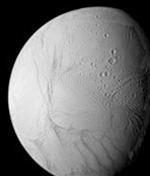 |
The images released by NASA show the surface of Saturn’s moon Enceladus as seen from the Cassini spacecraft. Photo: AP |
The U.S. space agency (NASA) announced yesterday (March 10) that the Cassini spacecraft has discovered geysers on one of Saturn’s moons, raising hopes for the possibility of life on planets beyond Earth.
The stunning images captured by the Cassini spacecraft from Saturn’s moon Enceladus indicate that liquid water may exist beyond Earth.
Most scientists agree that the essential components for life include liquid water and a stable heat source. However, evidence of large quantities of liquid water on extraterrestrial bodies is often indirect and based on inferences drawn from analyses of rocks and other data by scientists.
Researchers have reported that the Cassini spacecraft recently captured high-resolution images showing geysers and fragments of ice at the southern pole of Enceladus. While these images do not directly show liquid water, scientists believe that ice and vapor must be generated from subsurface reservoirs.
Torrence Johnson, a NASA scientist in charge of the Cassini mission, stated that these images have provided scientists with evidence of liquid water on the surface of another celestial body for the first time.
From this discovery, some scientists suggest that Enceladus should be added to the short list of planets in the Solar System that may host life beyond Earth. This life could be in the form of bacteria or primitive organisms capable of surviving in extremely harsh conditions.
Saturn is approximately 1.3 billion kilometers from Earth. Enceladus has a diameter of 502 kilometers and is the brightest object in the Solar System. According to scientists, this moon has undergone significant geological changes, and its southern pole is warming unusually (currently at -183°C, which is 20°C higher than the surrounding area).
TUONG VY



















































